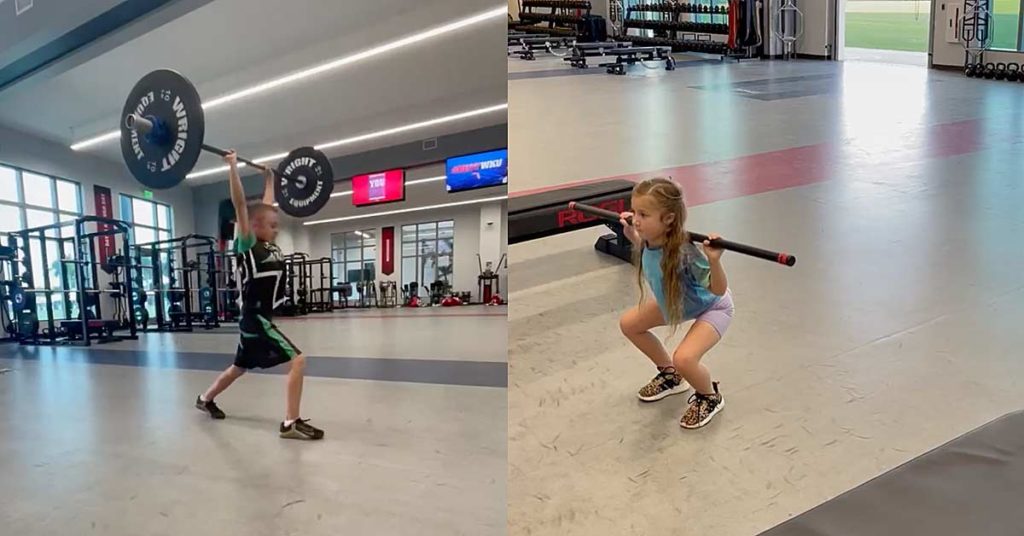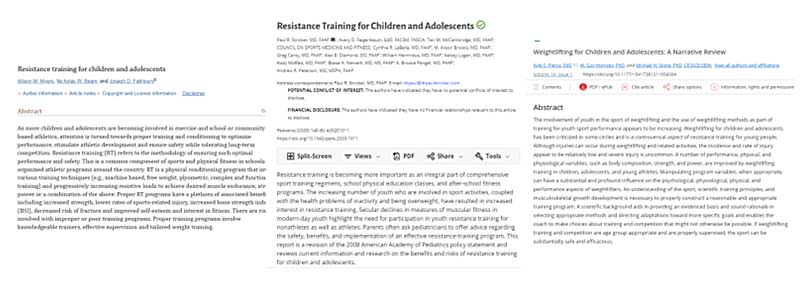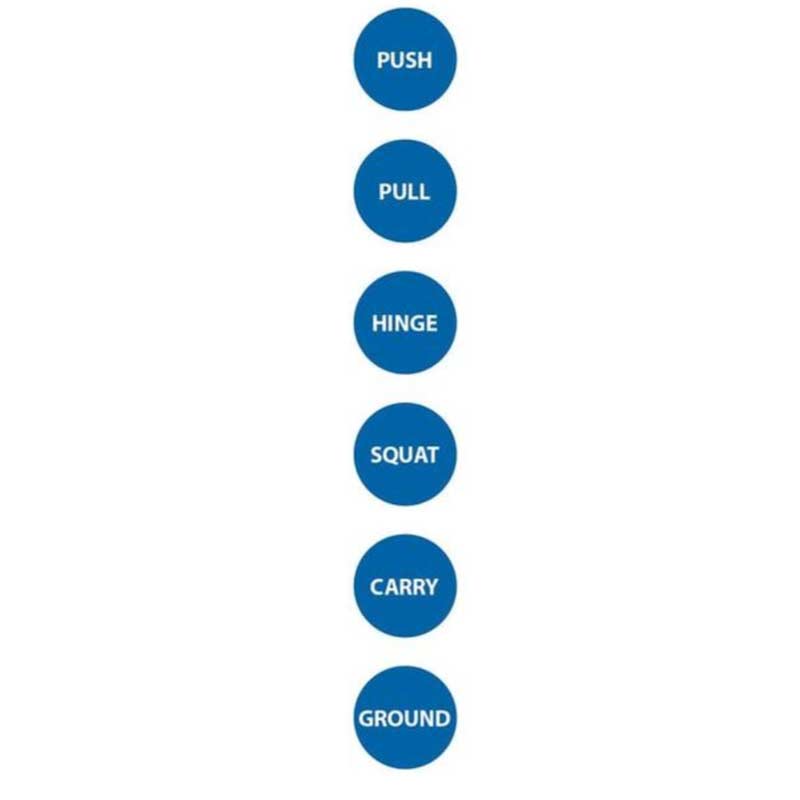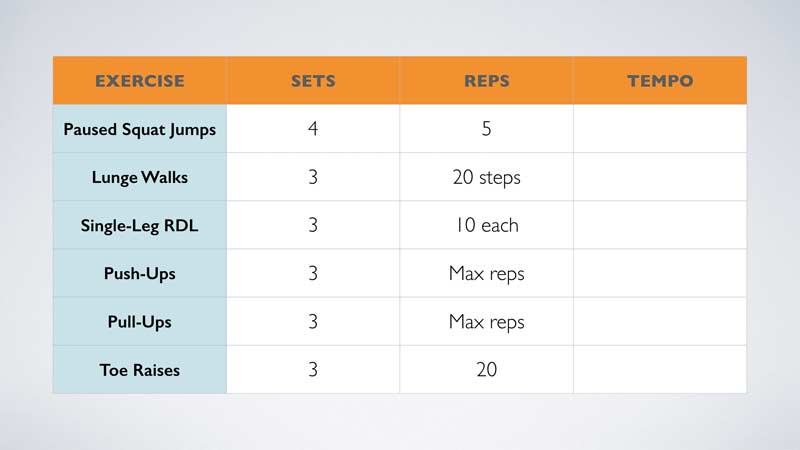
Most athletes have that story from their own childhood of encountering an opponent who had a specific push-up routine or did pull-ups. At the time, you were convinced those opponents had superpowers and a cheat code—they were far more mature and advanced for the level of competition because their guardians or crazy uncle had a calisthenics program from the ’70s they’d already been introduced to.
Why not have that advanced competitor be your son or daughter, but with a much more progressive and thorough plan for long-term development?
“Long-term development” has become a buzzword in recent years and, in many cases, has become controversial. Current research and progressive training models are washing away the old myths that kids shouldn’t train and that development comes exclusively from exposure to play and sports.
Research and progressive training models are washing away the old myths that kids shouldn’t train and development comes exclusively from exposure to play and sports, says @CoachJoeyG. Share on XKids don’t play anymore—it’s an epidemic that started with the emergence of video games. The days of staying out until the street lights come on are gone. I can’t tell you the last time I’ve seen a group of kids riding bikes or playing pickle in my neighborhood. Practitioners can’t keep claiming that the jungle gym will be enough to increase the movement toolbox, strength, and resiliency to overuse injuries because kids don’t go to the playground anymore. Video games and the AAU circuit have robbed kids of the self-exploration phase of movement development.
Introduction to training at a young age can not only immediately improve performance but also set that child up for long-term success. Every parent is convinced they are raising the next Lebron, Tiger, or Bryce Harper. It is perfectly normal, especially as a former athlete, to want your child to be special in whatever endeavor they decide to pursue.
Parents are tossing their children into Olympic-level training regimes in one sport, hoping to develop the next superstar. We see this with the early specialization that occurs in many youth sports. Sports such as basketball, baseball, and soccer have become year-long sports that afford no time off. The business side of youth sports wants to keep kids on AAU teams year round, paying for tournaments and special skill development coaches. Parents are discouraged from letting kids explore other sports or just playing with other kids in an unstructured venue for fear of them falling behind and not being the stud on the team.
Long-term development is not a topic being discussed in the bleachers of an 8U football game, and I speak from personal experience. Parents want to brag and live through the successes of their children. This isn’t an issue until it limits the child’s development and exposes them to potential injury from overuse. Because of this short-sighted view, kids aren’t developing the same movement toolbox. We are seeing movement limitations due to the absence of general movement prep or general strength training that kids used to get from playing at the park, doing general physical activities in PE, or playing multiple sports throughout the year.
Kids now go from the specialized skills trainer who only focuses on one sport to the couch to play video games to the field of play in the same sport year-round. There is no variation in movement, nor is there much general skill and strength development—injuries that used to occur in college are now found on the youth sports diamond or pitch.
Most parents are willing to sacrifice time and money to provide their children with more opportunities than they were afforded when they were young. One of the best parts about being a strength and conditioning coach is that I can provide a plan to develop my own children while also understanding their genetic limitations, as they are mine as well. Having both a young son and daughter who have gravitated toward sports has provided me with joy and a mission: to provide the appropriate environment for their athletic development without turning them away from the sports.
Training, no matter the level of the athlete, requires high levels of exertion that, for children, can be a turnoff if not introduced appropriately and reinforced with success. Young athletes can greatly benefit from training: increases in speed, power, strength, and, most importantly, basic body control can be gained in small time frames with simple modalities and exposures. General strength training and movement skill development will only set your child up for long-term success and mitigate several long-term injury issues.
In this article, I will detail how training youth:
- Is backed by research.
- Can be fun and competitive.
- Can decrease injury rates.
- Increases long-term performance.
- Boosts confidence and body image.
Along with these benefits, I will also outline how I approach the programming and training of my children.
Video 1. General strength training and movement skill development will set young athletes up for long-term success and mitigate several long-term injury issues.
Breaking Old Urban Myths
Strength training will not stunt your child’s growth if loaded and introduced appropriately. I repeat: strength training will not stunt your child’s growth if loaded and introduced appropriately!
Strength training will not stunt your child’s growth if loaded and introduced appropriately, says @CoachJoeyG. Share on XThere is far more mechanical stress imposed on a child jumping off a swing set than one performing a set of squats with a load less than body weight. This idea that making a child stronger is harmful is not only absurd but very untrue. Parents don’t hesitate to sign up their children for football or watch their son pitch off a mound twice in a weekend but will debate over allowing their kids to participate in beginner weight training even though the two sports above are far more stressful and have a much higher risk of injury.
Katherine Stabenow Dahab stated in her research paper “Strength Training in Children and Adolescents” that: “Children can improve strength by 30% to 50% after just 8 to 12 weeks of a well-designed strength training program. Youth need to continue to train at least 2 times per week to maintain strength. The case reports of injuries related to strength training, including epiphyseal plate fractures and lower back injuries, are primarily attributed to the misuse of equipment, inappropriate weight, improper technique, or lack of qualified adult supervision.”
The key takeaway of this article is that, under proper guidance, kids can benefit tremendously from lifting. People get hurt when they misuse equipment or exhibit poor technique. Let’s place blame not on the tool but on the person using the tool or the person teaching someone to use the tool.
Videos 2 & 3. Under proper guidance, kids can benefit tremendously from lifting.
The Twitter community is quick to condemn a video of an 8-year-old squatting 45 pounds but will post a video of their kid checking another kid on the hockey rink or their kid’s highlights from the weekend basketball tournament where they played six games. It is our responsibility as S&C coaches with kids to break these myths. A simple Google search will provide a plethora of support for introducing kids to training.

Start Slow: A-B-C’s of Movement
The biggest and most dangerous thing I see when people train youth athletes (or any athlete) is rushing and implementing advanced training methods far beyond the capabilities of the athlete being trained. I have seen kids go from learning a new movement pattern to immediately loading that same pattern within the same workout.
It’s the people trying to break records with kids or advance too fast who are contributing to this idea that lifting early is dangerous, says @CoachJoeyG. Share on XIt’s the people trying to break records with kids or advance too fast who are contributing to this idea that lifting early is dangerous. Putting two times body weight on a kid’s back for the sake of some youth record is insane and does not have the best interest of their development in mind. Anytime a load close to 1RM is prescribed, the risk of injury increases, no matter the age. The progression of load application and exercises should have logical steps and time frames.

Improving simple and commonly used movement patterns—such as squatting, hinging, pushing, and pulling—should be the mainstay in all athletic development. Improving bodyweight variations of these exercises should be the ground level of youth training. Add in a lunge or single-leg squat, and you set up that young athlete for success later in life.
-
BW execution of movement pattern
Increased volume of BW execution
Added external load of movement pattern (minimal load)
Increase volume of movement with minimal load
Increase load of movement slightly
Repeat the process over years

You can use the same approach for speed and movement skills on the field or court. Acceleration, deceleration, max velocity running, and change of direction are skills that must be taught before throwing the youth athlete into a full constraints-led approach. Coaches must give athletes the clues necessary to figure out the complex problems provided by sport.
Coaches are not meant to create robots but also must provide and guide athletes into a movement bandwidth that allows them to move faster, smoother, and with reduced risk of injury. Learning how to perform any of the mentioned skills better can prevent negative movement competencies and save time for coaches later on in the athlete’s life, which could lead to greater specific skill development and better players.
These early progression movements are like teaching children the alphabet. They have to understand the letters before they can form sentences, says @CoachJoeyG. Share on XThese early progression movements are like teaching children the alphabet. They have to understand the letters before they can form sentences. Coaches love to skip ahead since progressions and early movement training are boring, but in my experiences with youth athletes, consistency is the main contributor to success. Having some element of learning every day will advance the athletes significantly, giving those youth athletes who train a competitive advantage.

Make It Fun
Gamifying any training—even at the college level—improves intent and engagement. We have to remember that these are kids, not mature professional athletes, so maintaining focus and effort will be connected to how fun the task is. Creating competition produces a higher level of focus. Creating prizes or awards for winners of the day gives the kids something to work for and brag about.
Common competitions could be push-up or pull contests. We have even used the best technique of the day award to emphasize safe, efficient lifting. We celebrate every achievement as well because training is hard, and a chest bump or high five goes a long way in increasing engagement. Remember, we are in the business of bringing people up; do not become negative with youth, as they are extremely sensitive to the energy of the coach.
Having the Edge
Youth resistance training not only better prepares children for competition but also sets them up for long-term success and a healthy lifestyle. Training, if progressed, can decrease injury rates in youth sports while providing a platform for future success. Training as a youth will increase the athlete’s confidence and positive body image.
You can’t flip a switch and turn into a champion, but you can develop habits and foundational movement and strength that could eventually turn you into an elite player, says @CoachJoeyG. Share on XParents—be smart and don’t rush the process of training. Teach children patience by progressing slowly and logically. You can’t flip a switch and turn into a champion, but you can develop habits and foundational movement and strength that could eventually turn you into an elite player. Resistance training youth athletes can turn your son or daughter into the superhero kid everyone wants to play like while setting up their long-term development, so they always have an edge on the competition.
Since you’re here…
…we have a small favor to ask. More people are reading SimpliFaster than ever, and each week we bring you compelling content from coaches, sport scientists, and physiotherapists who are devoted to building better athletes. Please take a moment to share the articles on social media, engage the authors with questions and comments below, and link to articles when appropriate if you have a blog or participate on forums of related topics. — SF


Great Read-Thanks Joey!